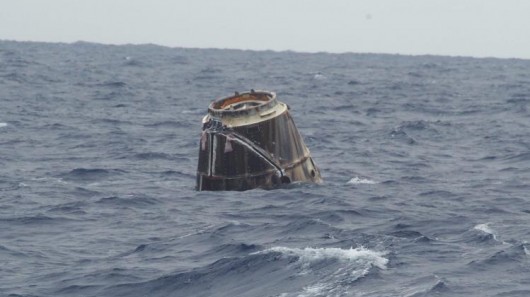Dragon spacecraft splashes down marking successful completion of historic mission
By Darren Quick
19:55 May 31, 2012
SpaceX’s Dragon spacecraft has splashed down safely in the Pacific Ocean, marking the successful completion of its mission in which a number of historic firsts were achieved. The splashdown came at approximately 11:42 US EDT, with the unmanned capsule landing in the waters roughly 500 miles (805 km) off the coast of Baja, California.
After its launch on May 22 atop a Falcon 9 rocket, the Dragon capsule became the first commercial spacecraft to dock with the International Space Station (ISS) on May 25. While attached to the ISS, 1,146 pounds (520 kg) of non-critical cargo that included food, other crew provisions and student experiments were unloaded, making room for the 1,455 pounds (660 kg) of cargo that was then packed onto the spacecraft to be returned to NASA. With other cargo vehicles servicing the ISS all destroyed after leaving the ISS, the reusable Dragon spacecraft is the only one capable of returning significant amounts of cargo to Earth.
While the journey to the ISS took 3 days, 6 hours, 11 minutes and 23 seconds, the return trip, from detaching from the ISS to splashing down in the Pacific Ocean, took just under six hours. After detaching from the ISS’s robotic arm at 5:49 am US EDT, a deorbit burn was carried out at 10:51 to decelerate the spacecraft. At 11:36, the spacecraft’s chutes were deployed and it splashed into the ocean six minutes later, awaiting recovery by boat.
The Dragon capsule after being retrieved from the Pacific Ocean after splashdown
“This really couldn’t have gone better,” said SpaceX CEO Elon Musk after the successful landing. “We look forward to doing lots more missions in the future and continuing to upgrade the technology.”
After recovery, the spacecraft will be transported to Texas. Musk has said the capsule will be put on display as a historic artifact, with other Dragon capsules to be built for future flights.
Copyright © gizmag 2003 - 2012 To subscribe or visit go to: http://www.gizmag.com

